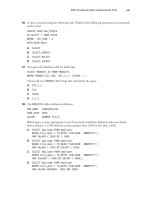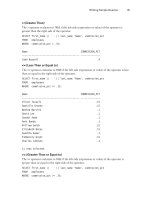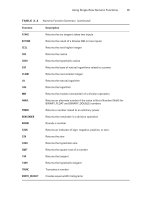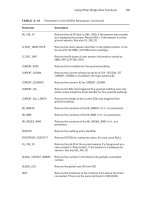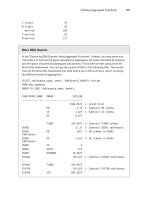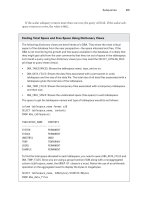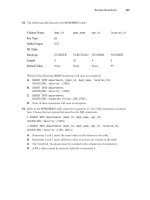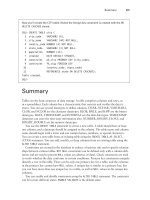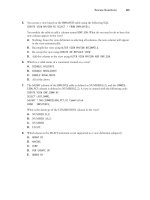OCA: Oracle Database 11g Administrator Certified Associate- P2
Bạn đang xem bản rút gọn của tài liệu. Xem và tải ngay bản đầy đủ của tài liệu tại đây (685.99 KB, 50 trang )
SQL Fundamentals I Assessment Test
xlv
36. A view is created using the following code. Which of the following operations are permitted
on the view?
CREATE VIEW USA_STATES
AS SELECT * FROM STATE
WHERE CNT_CODE = 1
WITH READ ONLY;
A. SELECT
B. SELECT, UPDATE
C. SELECT, DELETE
D. SELECT, INSERT
37. You query the database with the following:
SELECT PRODUCT_ID FROM PRODUCTS
WHERE PRODUCT_ID LIKE ‘%S\_J\_C’ ESCAPE ‘\’;
Choose the two PRODUCT_ID strings that will satisfy the query.
A. BTS_J_C
B. SJC
C. SKJKC
D. S_J_C
38. The EMPLOYEE table is defined as follows:
EMP_NAME VARCHAR2(40)
HIRE_DATE DATE
SALARY NUMBER (14,2)
Which query is most appropriate to use if you need to find the employees who were hired
before January 1, 1998 and have a salary greater than 5,000 or less than 1,000?
A. SELECT emp_name FROM employee
WHERE hire_date > TO_DATE(‘01011998’,’MMDDYYYY’)
AND SALARY < 1000 OR > 5000;
B. SELECT emp_name FROM employee
WHERE hire_date < TO_DATE(‘01011998’,’MMDDYYYY’)
AND SALARY < 1000 OR SALARY > 5000;
C. SELECT emp_name FROM employee
WHERE hire_date < TO_DATE(‘01011998’,’MMDDYYYY’)
AND (SALARY < 1000 OR SALARY > 5000);
D. SELECT emp_name FROM employee
WHERE hire_date < TO_DATE(‘01011998’,’MMDDYYYY’)
AND SALARY BETWEEN 1000 AND 5000;
95127flast.indd 45 2/18/09 6:16:18 AM
Please purchase PDF Split-Merge on www.verypdf.com to remove this watermark.
xlvi
SQL Fundamentals I Assessment Test
39. What happens when you issue the following command? (Choose all that apply.)
TRUNCATE TABLE SCOTT.EMPLOYEE;
A. All the rows in the table EMPLOYEE owned by SCOTT are removed.
B. The storage space used by the table EMPLOYEE is released (except the initial extent).
C. If foreign key constraints are defined to this table using the ON DELETE CASCADE
clause, the rows from the child tables are also removed.
D. The indexes on the table are dropped.
E. You cannot truncate a table if triggers are defined on the table.
40. Which two statements will drop the primary key defined on table EMP? The primary key
name is PK_EMP.
A. ALTER TABLE EMP DROP PRIMARY KEY;
B. DROP CONSTRAINT PK_EMP;
C. ALTER TABLE EMP DROP CONSTRAINT PK_EMP;
D. ALTER CONSTRAINT PK_EMP DROP CASCADE;
E. DROP CONSTRAINT PK_EMP ON EMP;
95127flast.indd 46 2/18/09 6:16:18 AM
Please purchase PDF Split-Merge on www.verypdf.com to remove this watermark.
Answers to SQL Fundamentals I
Assessment Test
1. B. In the arithmetic operators, unary operators are evaluated first, then multiplication
and division, and finally addition and subtraction. The expression is evaluated from left to
right. For more information about order of evaluation, see Chapter 1.
2. A, C. The CREATE FORCE VIEW statement can be used to create a view before its base table
is created. In versions prior to Oracle 11g, any modification to the table will invalidate
the view. In Oracle 11g, the view will be invalidated only if the columns used in the view
are modified in the base table. Use the ALTER VIEW <view name> COMPILE statement to
recompile the view. See Chapter 7 to learn more about views.
3. C. CONCAT will return a non-NULL if only one parameter is NULL. Both CONCAT parameters
would need to be NULL for CONCAT to return NULL. The NULLIF function returns NULL if the
two parameters are equal. The LENGTH of a NULL is NULL. INSTR will return NULL if NULL is
passed in and the tangent of a NULL is NULL. For more information about NULL values, see
Chapter 2.
4. C. Group functions cannot appear in the WHERE clause. To learn more about group func-
tions, see Chapter 3.
5. B. When updating multiple columns in a single UPDATE statement, the column assignments
in the SET clause must be separated by commas, not AND operators. To read more about
DML statements (INSERT, UPDATE, and DELETE), refer to Chapter 5.
6. C. Since job_id is used in the SELECT clause, it must be used in the GROUP BY clause also.
To learn more about the rules of using the GROUP BY clause and aggregate functions, read
Chapter 3.
7. B. The BFILE datatype stores only the locator to an external file in the database; the actual
data is stored as an operating system file. BLOB, NCLOB, and CLOB are the other large
object data types in Oracle 11g. UROWID is Universal ROWID datatype and EXTERNAL
is a not a valid datatype. See Chapter 6 for information about datatypes.
8. C. The statement will work without error. Option B would be correct if you used the WITH
CHECK OPTION clause in the subquery. See Chapter 4 for more information about subqueries.
9. A, E. An outer join on both tables can be achieved using the FULL OUTER JOIN syntax.
You can specify the join condition using the ON clause to specify the columns explicitly or
using the USING clause to specify the columns with common column names. Options B and
D would result in errors. In option B, the join type is not specified; OUTER is an optional
keyword. In option D, CROSS JOIN is used to get a Cartesian result, and Oracle does not
expect a join condition. To learn more about joins, read Chapter 4.
95127flast.indd 47 2/18/09 6:16:18 AM
Please purchase PDF Split-Merge on www.verypdf.com to remove this watermark.
xlviii
Answers to SQL Fundamentals I Assessment Test
10. A, B. The index contains all the information needed to satisfy the query in option A, and a
full-index scan would be faster than a full-table scan. A subset of index columns is specified
in the WHERE clause of option B; hence, Oracle 11g can use the index. For more information
on indexes, see Chapter 7.
11. D. The CREATE SEQUENCE statement will create an increasing sequence that will start with
1, will increment by 1, and will be unaffected by the rollback. A rollback will never stuff
vales back into a sequence. See Chapter 7 to learn more about sequences.
12. B, C. Primary and unique key constraints can be enforced using nonunique indexes.
Unique constraints allow NULL values in the columns, but primary keys do not. Read Chap-
ter 6 to learn more about constraints.
13. B. The SYSDATE function returns the date and time on the server where the database
instance is started. CURRENT_DATE returns the local date and time. For information on the
built-in date functions, read Chapter 2.
14. D. The first INSERT statement and last INSERT statement will be saved in the database. The
ROLLBACK TO A statement will undo the second and third inserts. To know more about
transaction control and ROLLBACK, read Chapter 5.
15. B. There should be at least n-1 join conditions when joining n tables to avoid a Cartesian
join. To learn more about joins, see Chapter 4.
16. C. The table and column names can include only three special characters: #, $, and _. No
other characters are allowed in the table name. You can have letters and numbers in the
table name. To learn more about table and column names, read Chapter 6.
17. B, D. You can use the IS NULL or IS NOT NULL operator to search for NULLs or non-NULLs
in a column. Since NULLs are sorted higher, they appear at the bottom of the result set in an
ascending-order sort. See Chapter 1 for more information about sorting NULL values.
18. D. COUNT (<column_name>) does not include the NULL values, whereas COUNT (*) includes
the NULL values. No other aggregate function takes NULL into consideration. To learn more
about aggregate functions, read Chapter 3.
19. E. These statements don’t account for possible NULL values in the BONUS column. For more
information about NULL values, see Chapter 2.
20. D. Using the ALTER TABLE statement, you can add new columns, rename existing columns,
and drop existing columns. To learn more about managing tables, read Chapter 6.
21. B. Since DEPARTMENT_ID is NULL for employee 178, NULL will be sorted after the non-NULL
values when doing an ascending-order sort. Since I did not specify the sort order or the
NULLS FIRST clause, the defaults are ASC and NULLS LAST. Read Chapter 1 for more infor-
mation on SELECT and sort orders.
22. D, E, F, G. The INTERVAL DAY TO SECOND datatype is used to store an interval
between two datetime components. See Chapter 6 for more information on the INTERVAL
and TIMESTAMP datatypes.
95127flast.indd 48 2/18/09 6:16:18 AM
Please purchase PDF Split-Merge on www.verypdf.com to remove this watermark.
Answers to SQL Fundamentals I Assessment Test
xlix
23. D, E. In the join view, CITY is the key-preserved table. You can update the columns of
the CITY table, except STATE_CD, because STATE_CD is not part of the view definition (the
STATE_CD column in the view is from the STATE table). Since I did not include the STATE_CD
column from the CITY table, no INSERT operations are permitted (STATE_CD is part of the
primary key). If the view were defined as follows, all the columns of the CITY table would
have been updatable, and new records could be inserted into the CITY table.
CREATE OR REPLACE VIEW state_city AS
SELECT b.state_cd, a.state_name, b.city_cd, b.city_name
FROM states a, cities b
WHERE a.state_cd = b.state_cd;
See Chapter 7 for more information about views.
24. B. When altering an existing column to add a NOT NULL constraint, no rows in the table
should have NULL values. In the example, there are two rows with NULL values. Creating
and modifying tables are discussed in Chapter 6.
25. D. NATURAL JOIN and JOIN…USING clauses will not allow alias names to be used. Since a
self-join is getting data from the same table, you must include alias names and qualify col-
umn names. To learn more about ANSI join syntax, read Chapter 4.
26. E. The TRUNC function used with a negative second argument will truncate to the left of the
decimal. To learn more about TRUNC and other numeric functions, read Chapter 2.
27. C. Oracle creates unique indexes for each unique key and primary key defined in the table.
The table ADDRESSES has one unique key and a primary key. Indexes will not be created for
NOT NULL or foreign key constraints. Constraints are discussed in Chapter 6.
28. D. Although there is no error in this statement, the statement will not return the desired
result. When a NULL is compared, you cannot use the = or != operator; you must use the IS
NULL or IS NOT NULL operator. See Chapter 1 for more information about the comparison
operators.
29. A. You cannot explicitly change the next value of a sequence. You can set the MAXVALUE or
INCREMENT BY value to a negative number, and NOCYCLE tells Oracle to not reuse a sequence
number. See Chapter 7 for more information.
30. B. Private synonyms override public synonyms, and tables or views owned by the user
always resolve first. To learn more about synonyms, see Chapter 7.
31. C, D. When COMMIT is executed, all locks are released, all savepoints are erased, and que-
ries started before the COMMIT will constitute a read-consistent view using the undo infor-
mation. To learn more about COMMIT, read Chapter 5.
32. B, C. The operators OR and AND are used to add more joining conditions to the query. NOT is
a negation operator, and a comma is used to separate column names and table names. Read
more about joins and join conditions in Chapter 4.
95127flast.indd 49 2/18/09 6:16:18 AM
Please purchase PDF Split-Merge on www.verypdf.com to remove this watermark.
l
Answers to SQL Fundamentals I Assessment Test
33. C. Since you are finding the aggregate of the aggregate, you should not use nonaggregate
columns in the SELECT clause. To read more about nesting of aggregate functions, see
Chapter 3.
34. B. You can create primary key, foreign key, and unique key constraints on a view. The con-
straints on views are not enforced by Oracle. To enforce a constraint, it must be defined on
a table. Views can be created with the WITH CHECK OPTION and READ ONLY attributes dur-
ing view creation. Read Chapter 7 to learn more.
35. A, C. The maximum lengths of CHAR and VARCHAR2 columns can be defined in charac-
ters or bytes. BYTE is the default. To learn more about CHAR and VARCHAR2 datatypes,
read Chapter 6.
36. A. When the view is created with the READ ONLY option, only reads are allowed from the
view. See Chapter 7 to learn more about creating views as read-only.
37. A, D. The substitution character % can be substituted for zero or many characters. The
substitution character _ does not have any effect in this query because an escape character
precedes it, so it is treated as a literal. Read Chapter 1 to learn more about substitution
characters.
38. C. You have two main conditions in the question: one on the hire date and the other on
the salary. So, you should use an AND operator. In the second part, you have two options:
the salary can be either more than 5,000 or less than 1,000, so the second part should be
enclosed in parentheses and should use an OR operator. Option B is similar to option C
except for the parentheses, but the difference changes the meaning completely. Option B
would select the employees who were hired before January 1, 1998 or have a salary greater
than 5,000 or less than 1,000. Read Chapter 1 to learn more about writing queries using
filtering conditions.
39. A, B. The TRUNCATE command is used to remove all the rows from a table or cluster. By
default, this command releases all the storage space used by the table and resets the table’s
high-water mark to zero. No indexes, constraints, or triggers on the table are dropped or
disabled. If there are valid foreign key constraints defined to this table, you must disable
all of them before truncating the table. Chapter 5 includes a comparison between using
TRUNCATE and the DELETE statement to remove rows.
40. A, C. Since there can be only one primary key per table, the syntax in option A works. Any
constraint (except NOT NULL) can be dropped using the syntax in option C. Learn more
about constraints in Chapter 6.
95127flast.indd 50 2/18/09 6:16:18 AM
Please purchase PDF Split-Merge on www.verypdf.com to remove this watermark.
Administration I Assessment Test
1. Which of the following is not considered part of Oracle Database?
A. Data files
B. Redo logs
C. Pfile and spfile
D. Control files
2. The following are the steps required for relocating a data file belonging to the USERS
tablespace. Order the steps in their proper sequence.
A. Copy the file /disk1/users01.dbf to /disk2/users01.dbf using an OS command.
B. ALTER DATABASE RENAME FILE ‘/disk1/users01.dbf’ TO ‘/disk2/users01.dbf’
C. ALTER TABLESPACE USERS OFFLINE
D. ALTER TABLESPACE USERS ONLINE
3. You manage one non-Oracle Database and several Oracle Databases. An application needs
to access the non-Oracle database as if it were part of the Oracle database. What tool
allows you to do this? (Choose the best answer.)
A. Oracle Advanced Security
B. Oracle Connection Manager
C. Heterogeneous Services
D. Oracle Net
E. None of the above
4. Choose two utilities that can be used to apply CPU patches on an Oracle 11g database.
A. Oracle Universal Installer
B. OPatch
C. EM Database Control
D. DBCA
5. The loss of a data file in which two tablespaces requires an instance shutdown to recover
the tablespace?
A. TEMP
B. SYSTEM
C. UNDO
D. SYSAUX
95127flast.indd 51 2/18/09 6:16:18 AM
Please purchase PDF Split-Merge on www.verypdf.com to remove this watermark.
lii
Administration I Assessment Test
6. Which of the following statements is not always true? (Choose two.)
A. Every database should have at least two tablespaces.
B. Every database should have at least two data files.
C. Every database should have at least three multiplexed redo logs.
D. Every database should have at least three control files.
7. Which statement about the initialization-parameter files is true?
A. The pfile and spfile can be modified using the ALTER SYSTEM statement.
B. You cannot have both an spfile and a pfile under the $ORACLE_HOME/dbs directory.
C. The pfile is used only to read by the Oracle instance, whereas the spfile is used to read
and write to.
D. On Windows systems, pfile and spfiles are not used because parameters are modified
using the system registry.
8. Which initialization parameter determines the location of the alert log file?
A. DIAGNOSTIC_DEST
B. BACKGROUND_DUMP_DEST
C. ALERT_LOG_DEST
D. USER_DUMP_DEST
9. Which parameter is used to set up the directory for Oracle to create data files if the
DATAFILE clause does not specify a filename when creating or altering tablespaces?
A. DB_FILE_CREATE_DEST
B. DB_CREATE_FILE_DEST
C. DB_8K_CACHE_SIZE
D. USER_DUMP_DEST
E. DB_CREATE_ONLINE_LOG_DEST_1
10. Which component of the SGA has the dictionary cache?
A. Buffer cache
B. Library cache
C. Shared pool
D. Program global area
E. Large pool
F. Result cache
95127flast.indd 52 2/18/09 6:16:18 AM
Please purchase PDF Split-Merge on www.verypdf.com to remove this watermark.
Administration I Assessment Test
liii
11. A constraint is created with the DEFERRABLE INITIALLY IMMEDIATE clause. What does
this mean?
A. Constraint checking is done only at commit time.
B. Constraint checking is done after each SQL, but you can change this behavior by speci-
fying SET CONSTRAINTS ALL DEFERRED.
C. Existing rows in the table are immediately checked for constraint violation.
D. The constraint is immediately checked in a DML operation, but subsequent constraint
verification is done at commit time.
12. You have just made changes to the listener.ora file for the listener called listener1
using Oracle Net Manager. Which of the following commands or combinations of commands
would you use to put the changes into effect with the least amount of client disruption?
A. lsnrctl stop listener1 followed by lsnrctl start listener1
B. lsrnctl restart listener1
C. lsnrctl reload listener1
D. lsnrctl reload
13. What is the prefix for dynamic performance views?
A. X$
B. V$
C. ALL_
D. DBA_
14. If you are updating one row in a table using the ROWID in the WHERE clause (assume that the
row is not already in the buffer cache), what will be the minimum amount of information
copied to the database buffer cache?
A. The entire table is copied to the database buffer cache.
B. The extent is copied to the database buffer cache.
C. The block is copied to the database buffer cache.
D. The row is copied to the database buffer cache.
15. When you are configuring Shared Server, which initialization parameter would you likely
need to modify?
A. DB_CACHE_SIZE
B. DB_BLOCK_BUFFERS
C. LARGE_POOL_SIZE
D. BUFFER_SIZE
E. None of the above
95127flast.indd 53 2/18/09 6:16:19 AM
Please purchase PDF Split-Merge on www.verypdf.com to remove this watermark.
liv
Administration I Assessment Test
16. To grant the SELECT privilege on the table HR.CUSTOMERS to all users in the database, which
statement would you use?
A. GRANT SELECT ON HR.CUSTOMERS TO ALL USERS;
B. GRANT SELECT ON HR.CUSTOMERS TO ALL;
C. GRANT SELECT ON HR.CUSTOMERS TO ANONYMOUS;
D. GRANT SELECT ON HR.CUSTOMERS TO PUBLIC;
17. Which of the following commands is most likely to generate an error message? (Choose two.)
A. ALTER SYSTEM SET UNDO_MANAGEMENT=AUTO SCOPE=MEMORY;
B. ALTER SYSTEM SET UNDO_MANAGEMENT=AUTO SCOPE=SPFILE;
C. ALTER SYSTEM SET UNDO_MANAGEMENT=MANUAL SCOPE=MEMORY;
D. ALTER SYSTEM SET UNDO_MANAGEMENT=MANUAL SCOPE=SPFILE;
E. ALTER SYSTEM SET UNDO_TABLESPACE=RBS1 SCOPE=BOTH;
18. The Automatic Workload Repository (AWR) is primarily populated with performance sta-
tistics by which Oracle 11g background process?
A. MMNL
B. QMN1
C. MMON
D. MMAN
19. You performed a SHUTDOWN ABORT on the database. What happens when you issue the
STARTUP command?
A. Startup will fail because you have not completed the instance recovery.
B. Oracle automatically performs recovery; all committed changes are written to data
files.
C. During instance recovery you have the option to selectively commit uncommitted
transactions.
D. After the database starts, you have to manually clean out uncommitted transactions
from the transaction table.
20. Which storage parameter is used to make sure that each extent is a multiple of the value
specified on dictionary-managed tablespaces?
A. MINEXTENTS
B. INITIAL
C. MINIMUM EXTENT
D. MAXEXTENTS
95127flast.indd 54 2/18/09 6:16:19 AM
Please purchase PDF Split-Merge on www.verypdf.com to remove this watermark.
Administration I Assessment Test
lv
21. Which of the following is the utility that you can use to test the network connections
across TCP/IP?
A. trcasst
B. lsnrctl
C. namesctl
D. ping
E. None of the above
22. What is the difference between a unique key constraint and a primary key constraint?
A. A unique key constraint requires a unique index to enforce the constraint, whereas a
primary key constraint can enforce uniqueness using a unique or nonunique index.
B. A primary key column can be NULL, but a unique key column cannot be NULL.
C. A primary key constraint can use an existing index, but a unique constraint always
creates an index.
D. A unique constraint column can be NULL, but the primary key column(s) cannot
be NULL.
23. Which of the following conditions prevents you from being able to insert into a view?
A. A TO_NUMBER function on one of the base table columns
B. A CONNECT BY clause in the view definition
C. A column of type RAW
D. All of the above
24. Which parameter is used to enable the Automatic Memory Management feature of the
Oracle 11g database?
A. MEMORY_MANAGEMENT
B. MEMORY_TARGET
C. SGA_TARGET
D. MEMORY_SIZE
25. Undo data in an undo tablespace is not used for which of the following purposes?
A. Providing users with read-consistent queries
B. Rolling forward after an instance failure
C. Flashback queries
D. Recovering from a failed transaction
E. Restoring original data when a ROLLBACK is issued
95127flast.indd 55 2/18/09 6:16:19 AM
Please purchase PDF Split-Merge on www.verypdf.com to remove this watermark.
lvi
Administration I Assessment Test
26. Which initialization parameter determines the window of flashback database operation?
A. DB_RECOVERY_FILE_DEST_SIZE
B. DB_FLASHBACK_RETENTION_TARGET
C. FAST_START_MTTR_TARGET
D. No initialization parameter; the window is determined by the RMAN backups.
27. When you started the Oracle 11g database, you got an “ORA-01157: cannot identify data
file…” error. After invoking RMAN, which command would you use before performing
REPAIR FAILURE?
A. RECOVER FAILURE
B. ADVISE FAILURE
C. LIST FAILURE
D. CHANGE FAILURE
28. Who is the owner of a directory object?
A. SYSTEM
B. SYSMAN
C. SYS
D. The user who creates the directory
29. Which of the following types of statements can use a temporary tablespace?
A. An index creation
B. SQL statements with a GROUP BY clause
C. A hash join operation
D. All of the above
30. Which of the following is false about shared servers?
A. Shared servers can process requests from many users.
B. Shared servers receive their requests directly from dispatchers.
C. Shared servers place completed requests on a dispatcher response queue.
D. The SHARED_SERVERS parameter configures the number of shared servers to start at
instance startup.
31. What is accomplished when you issue the following statement?
ALTER USER JOHN DEFAULT ROLE ALL;
A. John is assigned all roles created in the database.
B. Existing roles remain the same, but future roles created will be enabled.
C. All of John’s roles are enabled except the roles with passwords.
D. All of John’s roles are enabled, including the roles with passwords.
95127flast.indd 56 2/18/09 6:16:19 AM
Please purchase PDF Split-Merge on www.verypdf.com to remove this watermark.
Administration I Assessment Test
lvii
32. Which initialization parameter determines the location of the alert log file?
A. LOG_ARCHIVE_DEST
B USER_DUMP_DEST
C. BACKGROUND_DUMP_DEST
D. DIAGNOSTIC_DEST
33. The highest level at which a user can request a lock is the
level.
A. schema
B. table
C. row
D. block
34. How can you prevent someone from using an all-numeric password?
A. Set the initialization parameter PASSWORD_COMPLEXITY to ALPHANUM.
B. Alter that user’s profile setting PASSWORD_COMPLEXITY to ALPHNANUM.
C. Alter the user’s profile to use a password-verify function that performs comparisons to
validate the password.
D. There is no mechanism that lets you prevent an all-numeric password.
35. Which of the following advisors is used to determine whether the database read-consistency
mechanisms are properly configured?
A. Undo Management Advisor
B. SQL Access Advisor
C. SQL Tuning Advisor
D. Memory Advisor
36. Where does Oracle Database record all changes made to the database that can be used for
recovery operations?
A. Control files
B. Redo log files
C. Alert log file
D. Parameter file
37. In the Disk Settings section of EM Database Control’s Configure Backup Settings page,
which of the following backup settings is not configurable?
A. Disk Backup Type
B. Control File Autobackup Format
C. Disk Backup Location
D. Parallelism
95127flast.indd 57 2/18/09 6:16:19 AM
Please purchase PDF Split-Merge on www.verypdf.com to remove this watermark.
lviii
Administration I Assessment Test
38. You need to copy the GL schema from production to qa_test, changing the tablespace
for indexes from gl_index to fin_indx. What is the best way to satisfy these
requirements?
A. First, use Data Pump to copy the schema without indexes. Then, change the default
tablespace for user GL in qa_test to fin_indx. Next, use Data Pump to copy the
indexes. Finally, change the default tablespace for user GL back to gl_data.
B. Use the dbms_metadata package to extract table and index DDL. Then, use Notepad
(or sed) to edit this DDL, changing the tablespace for the indexes. Finally, run the
DDL in the qa_test database.
C. Use Data Pump import, specifying a remap_datafile parameter to change the data
file location for indexes.
D. Use Data Pump import, specifying a remap_tablespace parameter to change the
tablespace location for indexes.
39. Identify the statement that is not true about checkpoints.
A. Instance recovery is complete when the data from the last checkpoint up to the latest
SCN in the control file has been written to the data files.
B. A checkpoint keeps track of what has already been written to the data files.
C. The redo log group writes must occur before a Commit complete is returned to
the user.
D. The distance between the checkpoint position in the redo log file and the end of the redo
log group can never be more than 90 percent of the size of the largest redo log group.
E. How much the checkpoint lags behind the SCN is controlled by both the size of the
redo log groups and by setting the parameter FAST_START_MTTR_TARGET.
40. The STATUS column of the dynamic performance view V$LOG contains what value if the
redo log file group has just been added?
A. INVALID
B. STALE
C. UNUSED
D. NULL
41. When performing Data Pump import using impdp, which of the following options is not a
valid value to the TABLE_EXISTS_ACTION parameter?
A. SKIP
B. APPEND
C. TRUNCATE
D. RECREATE
95127flast.indd 58 2/18/09 6:16:19 AM
Please purchase PDF Split-Merge on www.verypdf.com to remove this watermark.
Administration I Assessment Test
lix
42. What would you do to reduce the time required to start the instance after a database crash?
A. Multiplex the redo log files.
B. Increase the size of the redo log files.
C. Set the FAST_START_MTTR_TARGET parameter to 0.
D. All of the above.
E. None of the above.
95127flast.indd 59 2/18/09 6:16:19 AM
Please purchase PDF Split-Merge on www.verypdf.com to remove this watermark.
lx
Answers to Administration I Assessment Test
Answers to Administration I
Assessment Test
1. C. Although pfiles and spfiles are physical files used to configure the Oracle instance, they
are not considered part of the database. To learn more about Oracle Database structure,
read Chapter 8.
2. C, A, B, D. To rename a data file, you need to make the tablespace offline so that Oracle
does not try to update the data file while you are renaming. Using OS commands, copy
the data file to the new location, and using the ALTER DATABASE RENAME FILE command
or the ALTER TABLESPACE RENAME FILE command, rename the file in the database’s con-
trol file. To rename the file in the database, the new file should exist. Bring the tablespace
online for normal database operation. See Chapter 10 for more information.
3. C. Heterogeneous Services is the correct answer because these services provide cross-
platform connectivity to non-Oracle databases. Oracle Advanced Security would not solve
this application problem because it addresses security and is not accessibility to non-Oracle
databases. Oracle Net would be part of the solution, but another Oracle Network com-
ponent is necessary. Connection Manager would also not be able to accommodate this
requirement on its own. Read Chapter 11 to learn more.
4. B, C. CPU patches and interim patches can be applied using the OPatch utility or using EM
Database Control. EM Database Control also includes patch search and download options.
See Chapter 17 for more information.
5. B, C. Only the SYSTEM and UNDO tablespaces require the instance to be shut down when
their data files need recovery. Read Chapter 16 to learn about database recovery.
6. C, D. Every database must have at least two redo log files, which may or may not be multi-
plexed. Every database must have one control file. It is a good idea to have more than one con-
trol file for redundancy. Since SYSTEM and SYSAUX are mandatory tablespaces in Oracle 11g,
there will be at least two data files. See Chapter 8 for more information.
7. C. A pfile is a read-only file, and no database changes are written to the pfile. There is no
harm in having both an spfile and a pfile in the $ORACLE_HOME/dbs directory; Oracle will
only read the spfile when starting the database. On Windows systems also, you will need
a parameter-initialization file; the registry is not used. Read more about parameter files in
Chapter 9.
8. A. Oracle 11g uses the Automatic Diagnostic Repository to maintain the alert log and other
diagnostic information. In pre–Oracle 11g databases, the BACKGROUND_DUMP_DEST parameter
determined the alert log location; in Oracle 11g, this parameter value is ignored. To learn more
about the alert log and its contents, read Chapter 9.
9. B. DB_CREATE_FILE_DEST specifies the directory to create data files and temp files. This
directory is also used for control files and redo log files if the DB_CREATE_ONLINE_LOG_
DEST_1 parameter is not set. Learn more in Chapter 10.
95127flast.indd 60 2/18/09 6:16:19 AM
Please purchase PDF Split-Merge on www.verypdf.com to remove this watermark.
Answers to Administration I Assessment Test
lxi
10. C. The shared pool has three components: the library cache, the result cache, and the dic-
tionary cache. Read Chapter 8 to learn more about SGA and Oracle instances.
11. B. DEFERRABLE specifies that the constraint can be deferred using the SET CONSTRAINTS
command. INITIALLY IMMEDIATE specifies that the constraint’s default behavior is to vali-
date the constraint for each SQL. Constraints are discussed in Chapters 7 and 10.
12. C. Although you can use option A to stop and start the listener, doing so temporarily dis-
rupts clients attempting to connect to the database. Option D is fine if you are starting and
stopping the default listener called LISTENER, but you are using a nondefault listener here.
Option B is not valid because RESTART is not a valid command-line argument for lsnrctl.
Therefore, the best method is to use the lsnrctl reload listener1 command to load the
new set of values in for the listener without disrupting connection service to the databases
that the listener is servicing. For more information, read Chapter 11.
13. B. Dynamic performance views begin with V$. The actual views have a prefix of V_$,
and the synonyms have a prefix of V$. The V$ views are based on the X$ tables, known as
dynamic performance tables. To learn more about dynamic performance views and tables,
read Chapter 9.
14. C. The block is the smallest unit that can be copied to the buffer cache. Information in the
dictionary cache is copied as rows. To learn about buffer cache and dictionary cache, read
Chapter 8.
15. C. Shared Server requires a shift of memory away from individual session processes to the
SGA. More information has to be kept in the SGA (in the UGA) within the shared pool. A
large pool is configured and is responsible for most of the SGA space allocation. Option C
is the correct answer. The cache size and block buffers settings do not affect Shared Server.
Read Chapter 11 for more information.
16. D. PUBLIC is the group or class of database users where all existing and future database
users belong. See Chapter 12 for more information.
17. A, C. You cannot dynamically change the parameter UNDO_MANAGEMENT after the instance
has started. You can, however, change the UNDO_TABLESPACE parameter to switch to another
undo tablespace while the instance is up and running. Read Chapter 13 to learn more.
18. C. The Manageability Monitor (MMON) process gathers performance statistics from
the system global area (SGA) and stores them in the AWR. Manageability Monitor Light
(MMNL) also does some AWR-related statistics gathering, but not to the extent that
MMON does. QMN1 is the process that monitors Oracle advanced queuing features.
Memory Manager (MMAN) is the process that dynamically manages the sizes of each SGA
component when directed to make changes by the Automatic Database Diagnostic Monitor
(ADDM). For more information, see Chapter 14.
19. B. Oracle automatically performs instance recovery after a database crash or SHUTDOWN
ABORT. All uncommitted changes are rolled back, and committed changes are written to
data files during instance recovery. Read Chapter 9 for more information.
95127flast.indd 61 2/18/09 6:16:19 AM
Please purchase PDF Split-Merge on www.verypdf.com to remove this watermark.
lxii
Answers to Administration I Assessment Test
20. C. The MINIMUM EXTENT parameter is used to make sure each extent is a multiple of the
value specified on dictionary-managed tablespaces. This parameter is useful to reduce frag-
mentation in the tablespace. Oracle discourages the use of dictionary-managed tablespaces.
You should use locally managed tablespaces. Read Chapter 10 for more information.
21. D. Protocols come with tools that allow you to test network connectivity. One such utility
for TCP/IP is ping. The user supplies either an IP address or a hostname to the ping util-
ity. It then searches the network for this address. If it finds one, it displays information on
data that is sent and received and how quickly it found this address. The other choices are
Oracle-supplied utilities. Read Chapter 11 for more information.
22. D. Columns that are part of the primary key cannot accept NULL values. Read Chapters 7
and 10 to learn more.
23. B. You cannot insert into a view that contains a CONNECT BY, ORDER BY, or GROUP BY
clause. Read Chapter 13 to learn more.
24. B. A nonzero value for the MEMORY_TARGET parameter enables Automatic Memory Man-
agement. SGA_TARGET enables Automatic Shared Memory Management. Automatic Memory
Management tunes both SGA and PGA components of the memory. To learn more, read
Chapter 14.
25. B. The online redo log files are used to roll forward after an instance failure; undo data is
used to roll back any uncommitted transactions. Read Chapter 13 to learn more.
26. B. The DB_FLASHBACK_RETENTION_TARGET parameter determines the window for the flash-
back database operation. The value is specified in minutes. So, a value of 1440 specifies
that the flashback database window is 1 day. To learn more, read Chapter 15.
27. B. REPAIR FAILURE works only after ADVISE FAILURE. Option A, RECOVER FAILURE, is
invalid. CHANGE FAILURE can be used to lower or raise the priority of a failure. To learn
more about automatically recovering from failures, read Chapter 16.
28. C. SYS is always the owner of directory object. You can grant read and write privileges on
the directory to users. See Chapter 17 to learn more.
29. D. Any operation that requires a large sort or other creation of temporary segments will
create, alter, and drop those temporary segments in the TEMPORARY tablespace. See Chap-
ter 12 for more information.
30. B. Shared servers can process requests from many users. The completed requests are placed
into the dispatchers’ response queues. The servers are configured with the SERVERS parame-
ter. However, shared servers do not receive requests directly from dispatchers. The requests
are taken from the request queue. Read Chapter 11 to learn more.
31. D. Default roles are enabled when a user connects to the database, even if the roles are
password-protected. See Chapter 12 for more information.
32. D. DIAGNOSTIC_DEST is new to Oracle 11g, and it determines the location of the alert log
file and trace files. Read Chapter 14 to learn more about alert log and trace file locations.
95127flast.indd 62 2/18/09 6:16:19 AM
Please purchase PDF Split-Merge on www.verypdf.com to remove this watermark.
Answers to Administration I Assessment Test
lxiii
33. B. The highest level at which a user can request a lock is the table level; the only other lock
level available to a user is a row-level lock. Users cannot lock at the block or schema level.
Read Chapter 13 to learn more.
34. C. There are no standard password-complexity settings in either the initialization param-
eters or the profiles. A password-verify function can validate new passwords against any
rules that you can code in PL/SQL, including regular-expression comparisons. See Chapter
12 for more information.
35. A. You can use the Undo Management Advisor to monitor and manage the undo segments
to ensure maximum levels of read consistency and minimize occurrences of “ORA-01555:
Snapshot Too Old” error messages. For more information, see Chapter 14.
36. B. Redo log files record all the changes made to Oracle Database, whether the changes are
committed or not. To learn more about redo log files and database recovery, read Chapters
15 and 16.
37. B. Settings such as the control file autobackup filename format and the snapshot-control
file destination filename must be configured using the RMAN command-line interface. To
learn more, read Chapter 15.
38. D. Options A and B are a lot of work. The remap_datafile parameter applies only
to CREATE TABLESPACE and CREATE DIRECTORY statements, not indexes. The remap_
tablespace parameter tells Data Pump import to change the tablespace that objects are
stored in between the source and the target database. See Chapter 17 for more information.
39. D. The distance between the checkpoint position in the redo log file and the end of the
redo log group can never be more than 90 percent of the size of the smallest redo log group.
Read Chapter 16 to learn more about checkpoints and instance recovery.
40. C. If the redo log file group has never been used, the value of STATUS is UNUSED until the
log file member is used to record redo information. Read Chapter 16 for more information.
41. D. REPLACE is the valid value; it drops the existing table and creates the table using the
definition from the dump file. SKIP leaves the table untouched. APPEND inserts rows to the
existing table. TRUNCATE leaves the structure but removes all existing rows before inserting
rows. See Chapter 17 to learn more.
42. E. To tune the instance-recovery time, configure the FAST_START_MTTR_TARGET parameter
to a nonzero value. The default is 300 seconds. A lower value will reduce the instance-recovery
time but may cause frequent checkpoints. A value of 0 turns off MTTR tuning. To learn
more, read Chapter 15.
95127flast.indd 63 2/18/09 6:16:19 AM
Please purchase PDF Split-Merge on www.verypdf.com to remove this watermark.
95127flast.indd 64 2/18/09 6:16:19 AM
Please purchase PDF Split-Merge on www.verypdf.com to remove this watermark.

